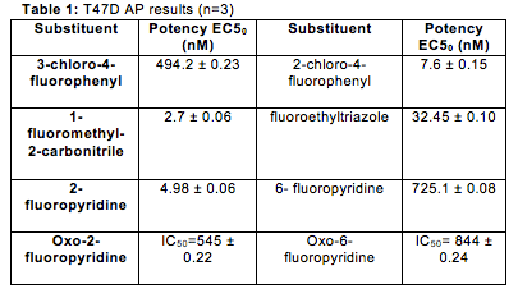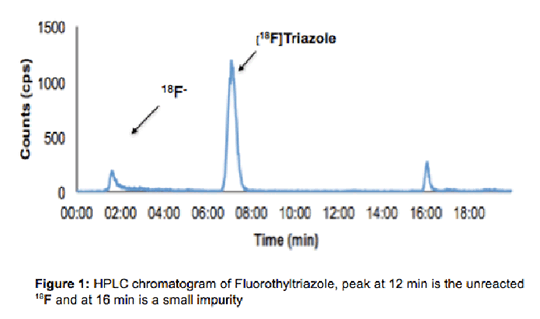268P Queen Elizabeth II Conference Centre London
Pharmacology 2014 |
Development of novel PET probes for measuring progesterone receptor expression
C Miranda1, L Allott1, J Greenman1, G Smith2, C Cawthorne1. 1The University of Hull, The School of Biological, Biomedical and Environment Sciences, Cottingham Road, Hull, UK, 2The Institute of Cancer Research, Division of Radiotherapy and Imaging, Old Brompton Road, UK
Endocrine therapy is an important systemic treatment for hormone receptor-positive breast cancer, with fewer side effects that chemotherapy and significant improvement in patient outcomes (1). Estrogen and progesterone receptor (ER, PR) expression are important biomarkers for selection of patients for endocrine therapy (1,2), and determination of the status of these receptors has become the standard of care in the treatment of breast cancer. Currently assessment is carried out using i mmunohistochemistry (IHC), which has several limitations e.g. the lack of a well-defined and reproducible cut-off value for positivity/unsuitability for the assessment of metastatic lesions (2). ER and PR are suitable targets for the development of imaging agents to allow non-invasive assessment, with 18F-Fluoroestradiol (FES) currently available in the clinic for the detection of ER expression (3) Since PR expression is regulated by ER, use of a PR ligand to assess changes in PR expression after anti-estrogen therapy may provide a better predictor of hormone therapy responsiveness (4). A number of steroidal 18F-agents for PR have been evaluated, including (18F-FFNP) which has progressed to clinical trial (4,5), however high levels of non-specific uptake were observed (5). Non-steroidal PR compounds such as Tanaproget have shown high specificity to PR with low cross-reactivity to other receptors (6). The purpose of this study was to screen a novel library of non-steroidal PR binding ligands for activity in the T47D assay with the goal of developing agents for PET imaging of PR expression in breast cancer for the prediction of endocrine therapy response. mmunohistochemistry (IHC), which has several limitations e.g. the lack of a well-defined and reproducible cut-off value for positivity/unsuitability for the assessment of metastatic lesions (2). ER and PR are suitable targets for the development of imaging agents to allow non-invasive assessment, with 18F-Fluoroestradiol (FES) currently available in the clinic for the detection of ER expression (3) Since PR expression is regulated by ER, use of a PR ligand to assess changes in PR expression after anti-estrogen therapy may provide a better predictor of hormone therapy responsiveness (4). A number of steroidal 18F-agents for PR have been evaluated, including (18F-FFNP) which has progressed to clinical trial (4,5), however high levels of non-specific uptake were observed (5). Non-steroidal PR compounds such as Tanaproget have shown high specificity to PR with low cross-reactivity to other receptors (6). The purpose of this study was to screen a novel library of non-steroidal PR binding ligands for activity in the T47D assay with the goal of developing agents for PET imaging of PR expression in breast cancer for the prediction of endocrine therapy response.


A focused library of non-steroidal PR ligands was synthesised based on the Tanaproget pharmacophore. These compounds were screened using the T47D alkaline phosphatase assay (6) (table 1). A suitable lead compound was selected based on EC50 value and ease of radiolabelling. This was radiolabeled with Fluorine-18 with good yield (figure 1). focused library of non-steroidal PR ligands was synthesised based on the Tanaproget pharmacophore. These compounds were screened using the T47D alkaline phosphatase assay (6) (table 1). A suitable lead compound was selected based on EC50 value and ease of radiolabelling. This was radiolabeled with Fluorine-18 with good yield (figure 1).
In summary, a focused library composed of novel non-steroidal PR ligands incorporating fluorine for eventual Fluorine-18 radiolabeling was screened for activity in the T47D assay. Radiolabeling of a selected lead compound has been achieved with good yield and the compound is undergoing further validation in preclinical models of cancer.
1. Sharaf et al. (2012) Cancer Ther 4:183-192
2. Ring et al. (2004) Endo-Rel Cancer 11:643–658
3. Mankoff et al. (2000) Neoplasia 2:71-88
4. Oliveira et al. (2013) Cur Med Chem 20:1-24
5. Dehdasthi et al. (2012) J Nucl Med 53:363-370
6. Zhang et al. (2005) J Biol Chem 31:28468–28475
|



